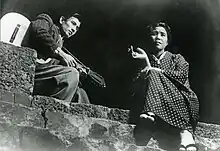A Japanese Tragedy
A Japanese Tragedy (日本の悲劇, Nihon no higeki), also known as Tragedy of Japan, is a 1953 Japanese drama film written and directed by Keisuke Kinoshita. The film tells the story of a mother who has to raise two children during and after World War II, but whose children reject her.[2][3] Kinoshita interspersed newsreel footage within the film in an attempt to relate the story of the film to the wider context of Japan's post-war difficulties.[4]
| A Japanese Tragedy | |
|---|---|
 | |
| Kanji | 日本の悲劇 |
| Directed by | Keisuke Kinoshita |
| Written by | Keisuke Kinoshota |
| Starring |
|
| Cinematography | Hiroshi Kusuda |
| Music by | Chuji Kinoshita |
Production company | |
| Distributed by | Shochiku |
Release date |
|
Running time | 116 |
| Country | Japan |
| Language | Japanese |
Plot
War widow Haruke, mother of two children, gets involved in prostitution during and after the Second World War to raise money for the family and secure the children a proper education. Her son Seiichi and daughter Utako, sharing a flat of their own, are embarrassed by their mother's activities and reluctant to her visits. Eager to cut ties with his past and poor upbringing, Seiichi, a medical student, aims at being adopted by an upper-class family. His sister Utako studies dressmaking and attends an English language school, engaging with her married teacher. Eventually, Seiichi's plan fulfils, while Utako, who claims that she can't lead a normal relationship after being raped by a cousin as a child, evokes a marital crisis. When Haruke finally realises that she has lost both her children, she commits suicide.
Cast
- Yūko Mochizuki as Haruko Inoue
- Yōko Katsuragi as Utako, Haruko's daughter
- Masumi Taura as Seiichi, Haruko's son
- Teiji Takahashi as Sato
- Keiji Sada as Tatsuya, a street musician
- Ken Uehara as Masayuki Akazawa, the English teacher
- Sanae Takasugi as Mrs. Akazawa
- Keiko Awaji as Wakamaru, a geisha
Reception
Alexander Jacoby regarded the personal conflict between the mother and her selfish children to be more "vivid" than the wider context provided by the newsreels.[4]
Isolde Standish points out that the newsreels give credence to the "subjective memories" of the characters that are shown in the film's flashback scenes.[5] For example, newsreel footage of American soldiers cavorting with Japanese women foreshadow a flashback scene depicting Haruko's decision to become a prostitute.[5] The flashbacks also provide contexts for the family's present day misunderstandings, when Haruko gets involved in the black market to provide food for the family, but her son Seiichi only knows that the activity causes him embarrassment at school, or when the children's cruel uncle tells them that their mother is enjoying herself at the Atami hot springs, while she is working as a prostitute to raise money for the family.[5]
According to film critic Donald Richie, A Japanese Tragedy was one of the first post-war films to focus on Japanese mothers, as Mikio Naruse's Repast was one of the first to focus on the plight of Japanese wives.[2]
Awards
Kinoshita won both the Mainichi Film Award and Blue Ribbon Award for best screenplay in 1953.[6][7] Yūko Mochizuki won the 1953 Mainichi Film Award for best actress.[7]
References
- "A Japanese Tragedy at the Japanese Movie Database" (in Japanese). Retrieved 21 January 2021.
- Richie, D. (2012). A Hundred Years of Japanese Film. Kodansha. pp. 117, 276. ISBN 9781568364391.
- "A Japanese Tragedy". Strictly Film School. Retrieved 24 November 2018.
- Jacoby, A. (2008). A Critical Handbook of Japanese Film Directors. Stone Bridge Press. ISBN 9781933330532.
- Standish, I. (2006). A New History of Japanese Cinema. Bloomsbury Publishing. pp. 204–208. ISBN 9781441161543.
- "1953 Blue Ribbon Awards" (in Japanese). Archived from the original on 7 February 2009. Retrieved 21 January 2021.
- "1953 Mainichi Film Awards" (in Japanese). Retrieved 21 January 2021.